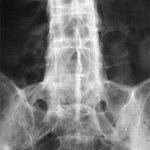Can bacteria in the gut or genitourinary tract trigger joint inflammation? One theory suggests that Chlamydial antigens share homology with peptides bound to HLA-B27, thus causing activation of the immune system as a result of molecular mimicry.13 However, bacterial stress in general, perhaps through pathogen-associated molecular patterns, may be sufficient to cause activation of an abnormal innate immune response that leads to an inflammatory arthritis. Similarly, mechanical stress and trauma at and around the joints may also trigger damage-associated molecular patterns and activation of the innate immune system, creating an inflammatory arthritis. The importance of physical stress to the pathogenesis of spondylarthritis is exemplified by the preference of inflammation in locations of repeated trauma such as the entheses, spine, and the lower extremity joints.6
The incidence of ReA around the world is probably related to the prevalence of arithrogenic bacteria and HLA-B27 positive patients in specific populations. The capability of bacteria to trigger ReA may vary among different strains of the same species. Epidemics of ReA have followed outbreaks of bacterial infections including Yersinia and Campylobacter in Finland, Shigella in Afghanistan, and Salmonella in Spain.9-12
The prognosis of ReA is usually good. For most patients, the episode of arthritis resolves within three to six months.18 The majority of patients do not develop a chronic inflammatory arthritis.19 A minority of patients will have a relapsing course, especially in the setting of repeated infections with the same organism, as likely happened to our patient. The risk of developing a more severe and chronic disease appears to be increased in those patients who are HLA-B27 positive.20
Send us Your Case Suggestion
Have you managed a patient with an unusual rheumatologic problem that you would want to present to a larger audience? Consider submitting your case to The Rheumatologist.
We are looking for interesting cases that are well written and that provide useful teaching points to the reader. Send an outline of your case presentation to Simon Helfgott, MD, at shelf [email protected], or visit www.The-Rheumatologist.org for more information.
The initial treatment of ReA usually includes nonsteroidal antiinflammatory drugs (NSAIDs), which can provide symptom relief but do not affect the course of disease. If the disease is severe, or there are significant systemic symptoms, some patients may benefit from oral corticosteroids. If ReA becomes chronic, disease-modifying antirheumatic drugs (DMARDs) such as sulfasalazine, methotrexate, or leflunomide can be added to the regimen. Small studies of adult patients have shown that tumor necrosis factor inhibitors appear to be safe and effective in patients with refractory disease.14 A recent case report also showed the efficacy of tocilizumab, an interleukin-6 receptor antagonist, in treating ReA.15


